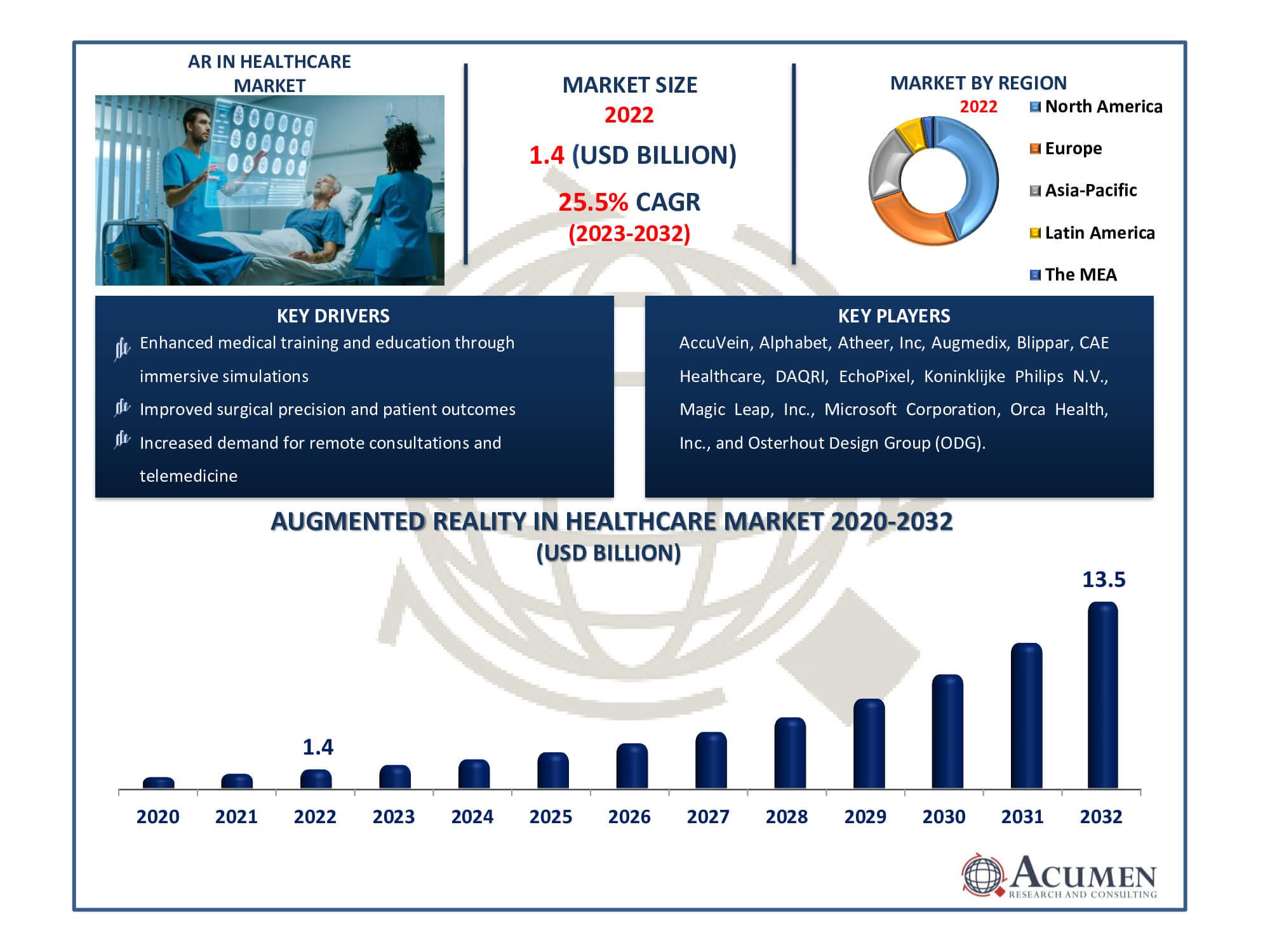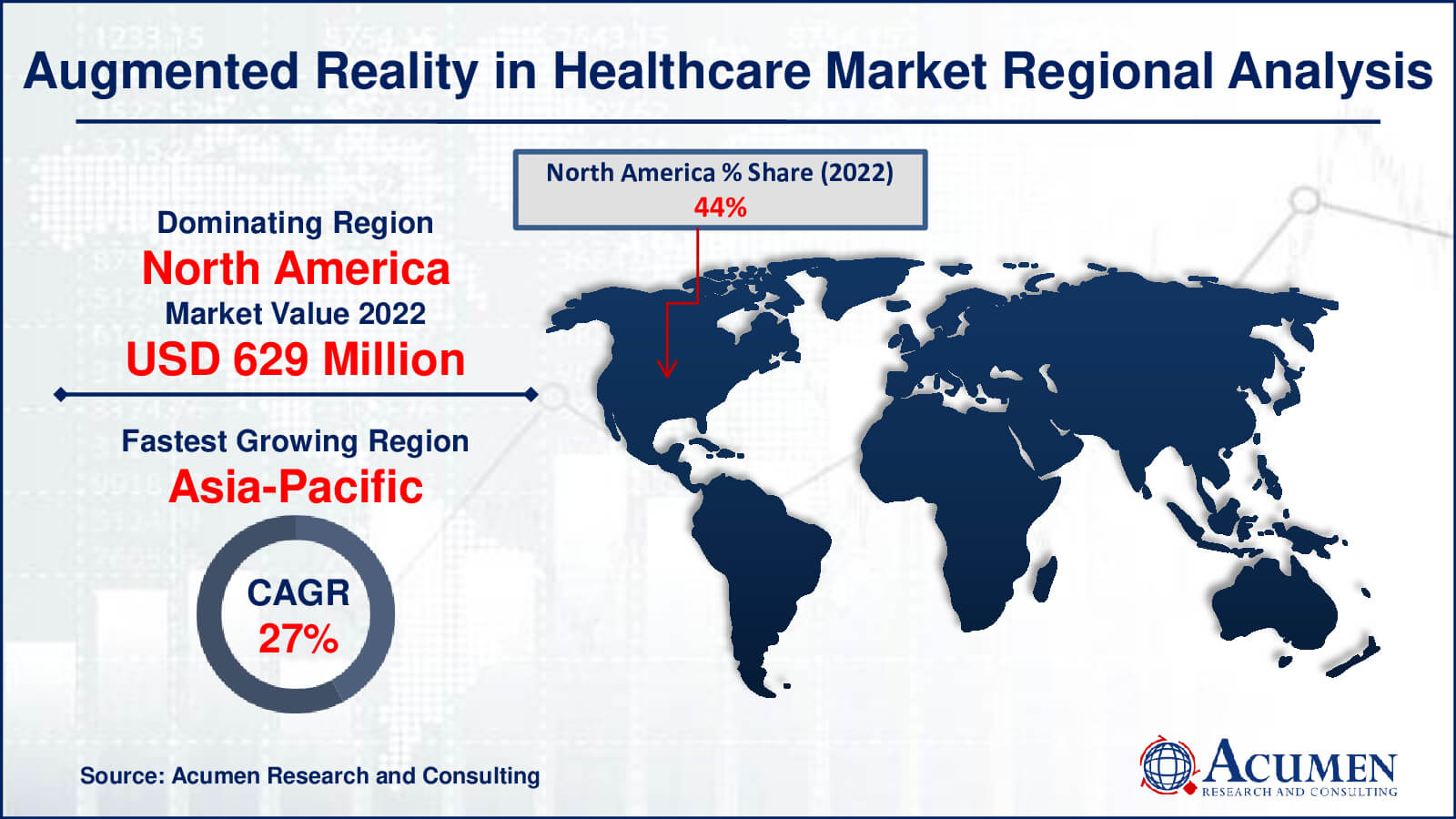June 2023
Augmented Reality in Healthcare Market Size accounted for USD 1.4 Billion in 2022 and is estimated to achieve a market size of USD 13.5 Billion by 2032 growing at a CAGR of 25.5% from 2023 to 2032.
The Augmented Reality in Healthcare Market Size accounted for USD 1.4 Billion in 2022 and is estimated to achieve a market size of USD 13.5 Billion by 2032 growing at a CAGR of 25.5% from 2023 to 2032.
Augmented Reality in Healthcare Market Highlights

Augmented reality (AR) is a technology that enhances a real-world environment by overlaying computer-generated perceptual information onto real-world objects. It uses the existing environment and adds information to create a new, artificial environment. In healthcare, AR is frequently used for educational purposes, allowing healthcare professionals to gain in-depth knowledge about anatomy and bodily functions. AR applications enable learners to visualize and interact with 3D representations of the human body. With AR applications, medical professionals can learn a great deal about the nuances of human anatomy and physiology. With the use of these resources, students can investigate and work with three-dimensional models of the human body, leading to a thorough comprehension of its intricate architecture and operations. AR is being used in medical education, where real-time data overlays and surgical simulations improve accuracy and safety during surgeries. AR helps healthcare professionals continuously enhance their knowledge and skills by creating an interactive and visually stimulating learning environment. This eventually improves patient care and advances medical science.
Global Augmented Reality in Healthcare Market Dynamics
Market Drivers
Market Restraints
Market Opportunities
Augmented Reality in Healthcare Market Report Coverage
| Market | Augmented Reality in Healthcare Market |
| Augmented Reality in Healthcare Market Size 2022 | USD 1.4 Billion |
| Augmented Reality in Healthcare Market Forecast 2032 | USD 13.5 Billion |
| Augmented Reality in Healthcare Market CAGR During 2023 - 2032 | 25.5% |
| Augmented Reality in Healthcare Market Analysis Period | 2020 - 2032 |
| Augmented Reality in Healthcare Market Base Year |
2022 |
| Augmented Reality in Healthcare Market Forecast Data | 2023 - 2032 |
| Segments Covered | By Product, By Device Type, By End-User, And By Geography |
| Regional Scope | North America, Europe, Asia Pacific, Latin America, and Middle East & Africa |
| Key Companies Profiled | AccuVein Inc., Alphabet Inc. (Google), Atheer, Inc, Augmedix, Blippar, CAE Healthcare, DAQRI, EchoPixel, Koninklijke Philips N.V., Magic Leap, Inc., Microsoft Corporation, Orca Health, Inc., Osterhout Design Group (ODG), Siemens Healthineers, Sony Corporation, and Virtually Better Inc. |
| Report Coverage |
Market Trends, Drivers, Restraints, Competitive Analysis, Player Profiling, Covid-19 Analysis, Regulation Analysis |
Augmented Reality in Healthcare Market Insights
The market dynamics of augmented reality (AR) in healthcare are being driven by a wide range of applications, from surgical preparation and minimally invasive procedures to medical training and pharmacy benefits management. Factors such as a growing population, increased demand for surgical treatments, and higher healthcare expenditures have expanded the real-world applications of AR. Technological advancements in AR and artificial intelligence (AI), coupled with the growing workload of healthcare professionals and strict regulatory compliance, are further fueling market growth. The increased adoption of mobile AR technology for patient education and information dissemination is enhancing the market's value. AR is also finding increased use in the healthcare sector for teaching complex subjects to medical students, training doctors, and providing post-hospitalization care and support to patients. On the other side, financial constraint and privacy issues are the factors projected to restrict the market growth in the near future.
Improved remote diagnosis and treatment is one major area of opportunity in the augmented reality (AR) healthcare sector. Real-time remote access and visualization of patient data is made possible by augmented reality (AR) technology, which facilitates prompt and precise diagnosis. AR can also make virtual consultations and telemedicine possible, increasing access to healthcare in underserved or inaccessible places. This offers a priceless chance to enhance patient care, lower healthcare expenses, and offer medical services to people who do not have easy physical access to medical institutions.
Augmented Reality in Healthcare Market Segmentation
The worldwide market for augmented reality in healthcare is split based on product, device type, end-user, and geography.
Augmented Reality in Healthcare Product
According to the augmented reality in healthcare industry analysis, the hardware segment dominated the market in 2022. Its dominance can be attributed to the solid and concrete foundation it offers. Healthcare personnel are equipped with the necessary tools to provide precise and effective patient care thanks to augmented reality technology, such as headsets and gadgets. With their accuracy, dependability, and smooth integration into medical operations, these gadgets have the potential to completely transform the way healthcare is delivered. AR technology guarantees that healthcare in the future will be not just virtual but also extraordinarily real and efficient with a robust hardware foundation.
Augmented Reality in Healthcare Device Type
As per the augmented reality healthcare market forecast, the head-mounted displays category expected to lead the market from 2023 to 2032. The immersive experience and hands-free convenience these devices provide to medical professionals account for their domination. Real-time augmented reality data overlay is made possible by head-mounted displays, which improve medical education, diagnosis, and surgical accuracy. Because of their ergonomic design, which reduces distractions and increases focus, they are an essential tool in contemporary healthcare. These gadgets allow medical practitioners to seamlessly blend the real and virtual worlds, giving patients access to state-of-the-art, patient-centered treatment unlike anything they've ever experienced.
Augmented Reality in Healthcare End-User
As the leading end-user segment in the augmented reality (AR) healthcare business, Hospitals and clinics command attention. The attraction of augmented reality (AR) in these contexts is its capacity to improve patient care and expedite medical processes. The diagnostic assistance, surgical accuracy, and patient education features of AR are extremely beneficial to hospitals and clinics. By using AR, they can provide innovative, individualised care, which will eventually enhance patient happiness and outcomes. Hospitals and clinics are ideally positioned to lead the way in introducing advanced technology and patient-centered healthcare in the future, as this is a recipe for success.
Augmented Reality in Healthcare Market Regional Outlook
North America
Europe
Asia-Pacific
Latin America
The Middle East & Africa

Augmented Reality in Healthcare Market Regional Analysis
The United States and Canada together make up the largest market for augmented reality in healthcare, which is found in North America. The domination is explained by a number of important variables. First off, the area has a very advanced healthcare system that places a high priority on technical innovation. Furthermore, the adoption of AR applications has been hastened by the existence of significant AR technology companies and top healthcare institutions. The United States of America maintains its leadership in healthcare technology thanks to significant investments and regulatory backing.
However, the market for augmented reality in healthcare has been expanding at the quickest rate in the Asia-Pacific area. The reasons for this quick expansion include rising healthcare costs, an ageing population, and an increased need for cutting-edge medical treatments. Furthermore, the Asia-Pacific area is becoming a hotbed for the adoption of augmented reality since several nations there are quickly adopting digital transformation in healthcare. The region's varied healthcare environment and growing population of tech-savvy individuals make it an ideal environment for the rapid development of augmented reality in healthcare applications.
Augmented Reality in Healthcare Market Players
Some of the top augmented reality in healthcare companies offered in our report includes AccuVein Inc., Alphabet Inc. (Google), Atheer, Inc, Augmedix, Blippar, CAE Healthcare, DAQRI, EchoPixel, Koninklijke Philips N.V., Magic Leap, Inc., Microsoft Corporation, Orca Health, Inc., Osterhout Design Group (ODG), Siemens Healthineers, Sony Corporation, and Virtually Better Inc.
Looking for discounts, bulk pricing, or custom solutions? Contact us today at sales@acumenresearchandconsulting.com
June 2023
December 2020
November 2020
April 2021